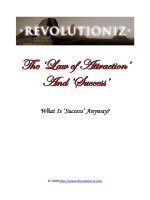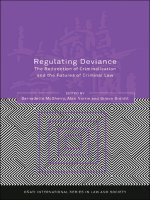The law of libraries and archives
Bạn đang xem bản rút gọn của tài liệu. Xem và tải ngay bản đầy đủ của tài liệu tại đây (2.78 MB, 331 trang )
TheLawofLibraries
andArchives
TheLawofLibraries
andArchives
BryanM.Carson
SCARECROWPRESS,INC.
PublishedintheUnitedStatesofAmerica
byScarecrowPress,Inc.
Awhollyownedsubsidiaryof
TheRowman&LittlefieldPublishingGroup,Inc.
4501ForbesBoulevard,Suite200,Lanham,Maryland20706
www.scarecrowpress.com
EstoverRoad
PlymouthPL67PY
UnitedKingdom
Copyright©2007byBryanM.Carson
Allrightsreserved.Nopartofthispublicationmaybereproduced,storedinaretrievalsystem,ortransmittedinanyformorby
anymeans,electronic,mechanical,photocopying,recording,orotherwise,withoutthepriorpermissionofthepublisher.
BritishLibraryCataloguinginPublicationInformationAvailable
LibraryofCongressCataloging-in-PublicationData
Carson,BryanM.,1965–
Thelawoflibrariesandarchives/BryanM.Carson.
p.cm.
Includesbibliographicalreferencesandindex.
ISBN-13:978-0-8108-5189-4(hardcover:alk.paper)
ISBN-10:0-8108-5189-X(hardcover:alk.paper)
1. Library legislation-United States. 2. Archives-Law and legislation-United States. 3. Fair use (Copyright)–United States. I.
Title.
KF4315.C372007
344.73'092-dc22
2006020318
The paper used in this publication meets the minimum requirements of American National Standard for Information
Sciences—PermanenceofPaperforPrintedLibraryMaterials,ANSI/NISOZ39.48-1992.
ManufacturedintheUnitedStatesofAmerica.
Tomyparents,
AdaLouCarsonandHerbertL.Carson,
whotaughtmehowtowrite
and
tomywife,GayleNovick,
whohasprovidedmyinspirationforthepastsixyears
Contents
Acknowledgments
1
LibrariesandtheU.S.LegalSystem
2
Contracts:AMeetingoftheMinds
3
CopyrightandPatentLaw
4
FairUseandIntellectualPropertyRights:TheBasicsofUsingInformationLegally
5
CopyrightandEducation
6
TrademarkandTradeSecretLaw
7
LicensingofIntellectualProperty
8
InformationMalpractice,Professionalism,andtheUnauthorizedPracticeofLaw
andMedicine
9
SearchWarrants,Investigations,LibraryRecords,andPrivacy
10
InternetUsePoliciesandtheFilteringDebate
11
EmploymentandWorkplaceLaw
12
FormingaNonprofitOrganization
Notes
Index
AbouttheAuthor
ExpandedTableofContents
Acknowledgments
Chapter1
LibrariesandtheU.S.LegalSystem
Chapter2.Contracts:AMeetingofMinds
Chapter3.CopyrightandPatentLaw
Chapter4.FairUseandIntellectualPropertyRights:TheBasicsofUsing
InformationLegally
Chapter5.CopyrightandEducation
Chapter6.TrademarkandTradeSecretLaw
Chapter7.LicensingofIntellectualProperty
Chapter8.InformationMalpractice,Professionalism,andthe
UnauthorizedPracticeofLawandMedicine
Chapter9.SearchWarrants,Investigations,LibraryRecords,andPrivacy
Chapter10.InternetUsePoliciesandtheFilteringDebate
Chapter11.EmploymentandWorkplaceLaw
Chapter12.FormingaNonprofitOrganization
SupplementalMaterialsonWebsite
HowtoReadaLegalCitation
Table1.1.ReportersContainingStateCourtCases
Table1.2.ReportersContainingFederalCourtCases
Table1.3.SetsContainingFederalStatutesandRegulations
Table1.4.Encyclopedias,Digests,andAnnotations
Conclusion
Chapter2
Contracts:AMeetingoftheMinds
DefinitionofaContract
AOffers
BAcceptance,Rejection,andCounter-Offers
CTheConceptsofConsiderationandReliance
DTheStatuteofFrauds
GovernmentalContracts
LegalDamagesforBreachofContract
ACompensatoryDamages
BPunitiveDamages
CConsequentialDamages
DLiquidatedDamages
EPromissoryEstoppel
EquitableDamages
AInjunctionsandSpecificPerformance
BReformationofContracts
CQuasi-contractualRemedies
IllegalContractsandAgreementsAgainstPublicPolicy
Conclusion
Chapter3
CopyrightandPatentLaw
CopyrightLaw
ADerivativeWorks
BInternationalProtectionforCopyrightLaw
CFairUse
InfringementofCopyright
ARemediesforCopyrightInfringement
BActualDamagesandStatutoryDamages
CTheSonyCase
DTheFile-SharingCases
TheWorkforHireDoctrine
AEmployeesversusIndependentContractors:TheReidCase
BStatutoryCategoriesandWorkforHireAgreements
Figure3.1.CopyrightAssignmentClause
CWorkforHireontheCollegeCampus
ExceptionstoCopyrightLawforLibrariesandArchives
Figure3.2.CopyrightNoticeforLibraries
DurationofCopyright
Table3.1.DurationofCopyright
TheU.S.PatentSystem
Conclusion
Chapter4
FairUseandIntellectualPropertyRights:TheBasicsofUsing
InformationLegally
WhatIsFairUse?
ATheNatureoftheUse
BTheNatureoftheCopyrightedWork
CAmountUsed,Substantiality,andEffectonPotentialMarket
DCananArtistPlagiarizeHimself?TheCaseofJohnFogerty
FairUseandtheConstitution:AFirstAmendmentRight?
FairUseandtheCommonLawofCopyrights
AStateCommonLaw,FederalCopyright,andtheQuestionofPreEmption
BCommonLawCopyrightandtheFairUseDoctrine
CCopyrightLawandUnfixedWorks
DUnpublishedManuscripts
Conclusion
Chapter5
CopyrightandEducation
WhatCanYouDoinaClassroomorLibrary?
ACopyrightandE-Reserves
DistanceEducationandCopyrightLaw
AThe1976CopyrightActandDistanceEducation
BTheTEACHActandTransmissionofPerformances
CWhattheTEACHActCovers
Figure5.1.CopyrightNoticeforOnlineClass
Conclusion
Chapter6
TrademarkandTradeSecretLaw
TrademarkLaw
ADilutionofTrademarks
BPalmingandReversePalming
CTheDastarCaseandtheRelationshipbetweenTrademarkand
Copyright
Trademarks,DomainNames,andCybersquatting
InternetLinkingandFraminginCopyrightandTrademarkLaw
ACopying,Displaying,andTransmittingFiles
BCopyrightandTrademarkIssueswithDeepLinkingandFraming
COtherLegalIssueswithLinkingandFraming
TradeSecrets
ATheCaseofthe“AncientFamilySecret!”
BReasonableEffortstoMaintainSecrecy
CLegalandEquitableRemediesforTradeSecrets
DLibrarianConfidentialityandTradeSecretLaw
Conclusion
Chapter7
LicensingofIntellectualProperty
TheUniformComputerInformationTransactionsActandtheAttempt
toCreateaSpecialLawofLicensing
AWhatIsUCITA?
BObjectionstoUCC2BandtheWithdrawaloftheAmericanLaw
Institute
CUCITARisesfromtheAshes
DObjectionstoUCITA
LicensingFreelanceArticlesforDatabases:TheCaseofTasiniv.
NewYorkTimes
ATasiniintheSupremeCourt
TheProcessofGettingPermission
Conclusion
Chapter8
InformationMalpractice,Professionalism,andtheUnauthorizedPractice
ofLawandMedicine
AvoidingtheUnauthorizedPracticeofLawandMedicine
AWhatKindsofAssistanceMayLibrariansProvide?
BTheVirginiaBarAssociationWeighsIn
CHowtoKeepOutofTrouble
DTheLibraryProfession’sEthicalCode
DoesInformationMalpracticeExist?
AWhatIsaProfessional?
BDefiningtheInformationProfessional’sDutyofCaretoPatrons
Conclusion
Chapter9
SearchWarrants,Investigations,LibraryRecords,andPrivacy
TheBasicsofSearchWarrantsforLibrariesandArchives
ATheFBILibraryAwarenessProgram
BTheFourthAmendmentandSearchWarrants
CProbableCause
DParticularity
EDueProcessintheLibrarySetting
StatePrivacyLawsforLibrariesandArchives
AWhatTypeofLibraryIsCovered?
BWhatTypeofInformationIsPrivate?
CWhatTypesofInformationMayBeDisclosed?
DPrivilegedCommunicationforLibrariesinGeorgiaandNew
York
EKentucky,Hawaii,andtheAttorneyGeneralOpinions
TheUSAPATRIOTAct
ATheFISACourt
BPenRegisterandWiretapProvisionsofthePATRIOTAct
CTheStandardforSearchWarrantsinSection215
DSection505andNationalSecurityLetters
ETheNondisclosureProvisionsofthePATRIOTAct
FHowtoHandleaLawEnforcementVisit
GRenewalofthePATRIOTAct
PatronConfidentialityandDutytoSociety:AnEthicalQuandary
ATheEthicalBackground
BTheSuicidalPatron
CTheImmediateThreatofPhysicalViolence
Conclusion
Table9.1.SourcesofStateandTerritorialLibraryPrivacyLaws
Table9.2.TypesofLibraryMaterialsProtectedbyStateand
TerritorialPrivacyLaws
NotesforTable9.1andTable9.2
Chapter10
InternetUsePoliciesandtheFilteringDebate
TheCIPADistrictCourtDecision
TheCIPAPluralityRulingbytheU.S.SupremeCourt
AChiefJusticeRehnquist’sOpinion
BJusticeBreyer’sConcurringOpinion
CJusticeKennedy’sConcurringOpinion
DJusticeStevens’Dissent
EJusticeSouter’sDissent
ReviewingInternetUsePolicies
NecessaryResourcesDiscussingInternetUsePolicies
Conclusion
Chapter11
EmploymentandWorkplaceLaw
AgencyLaw
TheEmploymentRelationship
AEmployeeorIndependentContractor?
BEmployment-at-WillandEmploymentContracts
CTerminatinganEmployee
Figure11.1.SampleLetterofWarningforanEmployee
DLaborUnionsandCollectiveBargaining
ETheFairLaborStandardsAct(FLSA)
FChildLaborLawsundertheFLSA
GHiringNewWorkers
Figure11.2.SampleAdvertisementforJobOpening
HDrugTestingintheWorkplace
IDiscriminationandHarassment
JTheAmericanswithDisabilitiesAct
KTheFamilyandMedicalLeaveAct
Conclusion
Table11.1.InappropriateandAppropriateUsesofPersonal
Questions
Chapter12
FormingaNonprofitOrganization
FormingaMissionStatementandSelectingaBoard
CreatingtheGoverningDocuments
AArticlesofIncorporation
BCreatingBylaws
CEthicsforBoardMembers
DTheSarbanes-OxleyActandNonprofits
ObtainingandMaintainingTax-ExemptStatus
Table12.1.Limitsfor26U.S.C.501(h)and26U.S.C.4911(c)(2)
Conclusion
Notes
Index
AbouttheAuthor
Acknowledgments
Iwouldliketothankthefollowingpeople,withoutwhomthisbookwouldnotbepossible:
Michael Binder, Dean of the Western Kentucky University Libraries, and Brian Coutts,
HeadoftheDepartmentofLibraryPublicServices.Dr.BinderandDr.Couttsencouragedme
topursuethisprojectandsupportedmethroughoutinmanyways,includinggrantingmeleave
toworkonmywriting.PhilMyers,thechairoftheIntellectualPropertyCommitteeatWKU,
and Laura Hagan, WKU’s intellectual property attorney, both contributed information and
suggestions.SallyKuhlenschmidtandtheTeachingResourceFacultygrantcommitteeprovided
financialsupportsothatIcouldattendtheconferenceIntellectualPropertyintheDigitalAge.
Terri Baker, Debra Day, Selina Langford, and Jan Gao in the Interlibrary Loan office
helped to facilitate myresearchbyfindingmaterialstheuniversitydidn’town.Withouttheir
assistance, my work would have been much more difficult. My colleague Haiwang Yuan
providedemotionalsupportandadvice,andhelpedmefindsourcesforsomequotes.
ItwasmycolleagueJackMontgomerywhofirstsuggestedthatIapplymylawbackground
toananalysisoflegalissuesinlibraries.JackintroducedmetoKatinaStrauch,theeditorof
Against the Grain. Many of the concepts discussed in this book began life as columns in
AgainsttheGrain.Katina’sassistanceandsupportwereinstrumentaltothecompletionofthis
project.
MycolleagueRobinMcGinnisassistedmewithproofreading.Evenmoreimportantly,it
was Robin who suggested that I write about the legal aspects of lobbying and marketing
campaigns, and she became my co-author for an article on that topic in Against the Grain.
WendyDrakehelpedmebyprovidinginformationontheJetLibrariansatNorthwestAirlines.
Laura“Lolly”Gassaway,directorofthelawlibraryattheUniversityofNorthCarolina,
ChapelHill,gavemepermissiontoincludeatablefromherWebsitewithinformationonthe
durationofcopyright.IalsoreceivedpermissiontousematerialthefromWebsiteofGeorgia
Harper, theintellectualpropertyexpertfortheGeneralCounsel’sOfficeattheUniversityof
TexasSystem.
I would be remiss if I didn’t thank my staff for all the assistance and understanding that
theyhavegivenmeduringthetimeIwaswritingthisbook.Theyhavehelpedmeinwaystoo
numeroustomention.Ireallycouldnothavecompletedthisworkwithouttheassistanceof(in
alphabeticalorder)PaulaBowles,PhilipEdwards,AlanLogsdon,NancyMarshall,Christina
Muia,ReneeReader,andCarubieRodgers.
SallyCraleyandtheproofreadersatScarecrowworkedhardtohelpeliminateerrors.If
youfindanymistakesinthetext,itismyfault,nottheirs.Myindexingteam,ColleenDunham
Indexing,Inc.,andChrisBantainparticular,tookextrastepstoensurethatreaderswillbeable
tofindinformationinthebook.
Ineedtothankmyeditor,MartinDillon,forprovidingassistance,answeringmyquestions,
andgenerallyguidingmetowardsabetterbook.Martin,Icouldn’thavedonethiswithoutyou.
Thankyouforeverything!
Lastbutnotleast,Ineedtothankmyparents,AdaLouCarsonandHerbertL.Carson,who
taughtmehowtowrite;andmywife,GayleNovick,forputtingupwithmeandprovidingas
muchassistanceaspossiblewhileIfinishedthebook.
1
LibrariesandtheU.S.LegalSystem
Lawisoftenconsideredtobeaspecializedarea,inaccessibletotheordinaryperson,asubject
youhavetogotolawschooltounderstand.Yetatthesametime,lawsimpactusonadaily
basis.Thelawbindseveryone;afterall,societylivesbytheoldmaximthat“ignoranceofthe
lawisnoexcuse.”
Thephilosophybehindthisbookisthatthelawshouldbeaccessibletoeveryone.Mygoal
is to explainlegalconceptsinplainEnglishsothatlibrariansandarchivistswillbeableto
understandtheprinciplesthataffectthemonadailybasis.Thisbookwillprovideitsreaders
withanswers,oratleastitwillraiseissuesforthereaderstothinkabout.Althoughthiswork
isabasicoverview,itcontainsenoughdetailstoallowreaderstomakeinformedchoicesand
totalkintelligentlywithlegalcounsel.
Ibelievethatlibrariansandarchivistsshouldlearnthebasiclegalprinciplesthatapplyto
ourdailylives.Librariansandarchivistswhoknowthelawarenotjustoperatinginthedark;
theyhaveanunderstandingofthelegalforcesthatimpacttheirprofession.Itismybeliefthat,
as professionals, librarians and archivists need to have a much deeper understanding of the
principlesoflibrarylawthanmostofuscurrentlyhave.
Manypeopleknowafewrulesthatseemtoprovidequickanswers.However,mostpeople
don’tunderstandwhythelawisthewayitis.Thereisalargeamountoflegalinformationin
thisbook.Mygoalisnottomakeyouintoalawyer,buttohelpyouunderstandthelawsothat
youcanstaywithinthelaw.
Alexander Pope oncesaid,“Alittlelearningisadangerousthing.”1Justknowing a few
rulescanbedangerous;understandingthelawisnotlikeapplyingacatalogingrule.Whenyou
apply a cataloging rule, “The rule is the rule is the rule.” There are no exceptions, no
“applications” to the situation. In the law, on the other hand, it is the policy and the history
behindtherulethatismoreimportantthantheruleitself.Inthelaw,rulesareflexibleenough
toapplytoeachparticularsetoffacts.Forthatreason,librariansneedtoknowthepolicyand
historybehindtherulesinordertostaywithinthelaw.
Sometimesthisbookmayreadmorelikealawbookthanalibrarysciencebook;however,
thatisdeliberate.Theideaisthat,afteryouhavereadthisbook,youwillnotonlyunderstand
therules,butyouwillalsounderstandwhythelawisfashionedthewayitis.Beingableto
understandthereasonsforthelawwillhelplibrariesandarchivestoruninamoreefficient
way, and will also allow information professionals to work with attorneys at a much higher
level. This will, in turn, allow legal counsel to do a better job of representing libraries and
archives.Ofcourse,themaingoalofunderstandingthelawistoenableustobetterassistour
patrons.
Inthisbook,Iwilloccasionallyofferadvicebaseduponmyeducationandexperiencein
law and librarianship. In some cases, I will advocate principles not specifically relating to
librariansorarchivists,norspecificallyaddressedbyprofessionalethicalcodes.TheadviceI
offerrepresentsonlymyviewsanddoesnotrepresenttheviewofmyemployer,mypublisher,
ormyeditors.
The medieval philosopher Maimonides once said that the highest form of charity is to
teach a person to help himself. My goal is to educate readers so that they understand the
fundamentalconcepts,keepingthemselveswithinthelawandavoidingproblems.
Thefollowingpagescontainbriefsummariesofthebook’sremainingchapters.
Chapter2.Contracts:AMeetingoftheMinds
Thebasicglueofourlivesisthecontract,whichwillbediscussedinChapter2.Contractlaw
is the underpinning for everything else we do. We sign contracts on a daily basis, for
everything from buying books to licensing databases, and from hiring new employees to
orderingnewcomputers.Chapter2willtellyouhowcontractsareformed,andwillexplain
thelawbehindcontractformation—includingoffers,acceptance,rejection,andcounteroffers.
This chapter will also discuss which contracts need to be put into writing so as to be
enforceable.
Sincemanylibrariesaregovernmentalentities,Chapter2willalsodiscusstheprocessfor
forming governmental contracts, including an overview of the Request for Proposal (RFP)
processandtheFederalAcquisitionRegulationSystem.2Thischapterwillalsodiscusslegal
andequitableremediesforbreach ofcontract.Chapter 2 willconcludewithadiscussionof
illegalcontractsandcontractsagainstpublicpolicy.
Chapter3.CopyrightandPatentLaw
Chapter3willdiscusscopyrightlawandpatentlaw.Copyrightsandpatentsarebasicforms
ofintellectualproperty guaranteed bytheU.S.Constitution. Intellectualpropertyprotectsthe
creationsofthemind,suchastheworkofauthors,artists,andinventors.Thereasonwehave
copyright law and patent law is to encourage authors, artists, inventors, and other creative
individuals, while also allowing the public to have access to written materials and to new
inventions.
Chapter 3 will begin with the basics of copyright law, a discussion of what types of
materials can be copyrighted, and an indication of how international copyright protection
works.Copyrightinfringementisanimportanttopicinanydiscussionofintellectualproperty.
ThissectionofChapter3willalso discussremediesforcopyright infringement.Thesection
willalsodiscusstheSonyBetamax3caseandtherecentfile-sharingcasesinvolvingNapster,4
Grokster,5 and StreamCast.6 These cases have great significance for the free exchange of
informationandfortheabilityoflibrarypatronstoaccesscopyrightedmaterials.
One very important concept in all areas of intellectual property is the Work for Hire
doctrine.7 This section of Chapter 3 will help to answer questions about what kind of
employmentisincludedintheWorkforHiredoctrine.TherewillalsobeadiscussionofWork
forHire on college campuses. In addition, Chapter3 will discuss the duration of copyright,
includingtheSonnyBonoCopyrightTermExtensionAct.8
Next, Chapter3 will discuss patentlaw. Librarians and archivists are a very important
partofthepatentsystembecauseinventors,lawyers,andpatentagentsmustsearchscientific
and popular literature. Information professionals can assist in determining whether the
inventionwastheresultof“priorart”(publishedmaterialsandwidelycirculatedunpublished
materials).Finally,thissectiongivesdetailsontheU.S.patentrequirementof“FirsttoInvent,”
anddiscussescurrentproposalstochangethispatentrequirementto“FirsttoFile.”
Chapter4.FairUseandIntellectualPropertyRights:The
BasicsofUsingInformationLegally
Thefairusedoctrine9isthebasicprinciplethatkeepscopyrightlawfromcreatinganabsolute
monopoly. Because of fair use, we are free to quote and comment on published and
unpublishedmaterials.FairuseistheprinciplethathelpstoreconciletheFreedomofSpeech
guaranteesoftheFirstAmendmentwiththeintellectualpropertyrestrictionsofcopyright.The
fairusedoctrineisthesubjectofChapter4,whichdiscusseshowmuchofawriter’sproduct
canbeborrowed,copied,orquotedbyanotherwriter.
Inordertodeterminewhetheraspecificsituationconstitutesfairuse,researchersneedto
askbasicquestionsaboutthenatureoftheutilization,thenatureofthecopyrightedmaterial,the
amount of the material that is used, and the effect of that use on the potential market for the
copyrighteditem.Anotherquestioninvolvesthedifferencebetweenthestyleofanartistversus
plagiarismofthatartist’smaterials.Thisissueisillustratedbythecaseofsinger/songwriter
JohnFogerty.
Fair use may also apply to common law copyright, although there is some controversy
about this issue. Common law copyright applies to materials that don’t qualify for Federal
copyright protection. Unfixed works such as lectures are covered by state common law.
Chapter4willdiscussthequestionoffairuseincommonlawcopyright.
Chapter5.CopyrightandEducation
How does copyright law affect the library and classroom? How does copyright law affect
librarye-reserves?Whatkindsofusesarelegalfordistanceeducation?Thesequestionsabout
copyrightandeducationwillbediscussedinChapter5.
Thischapterwilldiscussissuesrelatingtocopyrightlawbothoncampusandindistance
education.Chapter5 will include the basic rules for classroom use. There will also be an
extensive discussion of the TEACH Act,10 which allows for transmission of some
performancesinadistanceeducationclass.
Chapter6.TrademarkandTradeSecretLaw
Trademark law and trade secret law are often thought of as only pertaining to large
companies.Nothingcouldbefurtherfromthetruth,asyouwillseeinChapter6.
Trademarks consist of “[w]ords, names, symbols, or devices used by manufacturers of
goodsandprovidersofservicestoidentifytheirgoodsandservices,andtodistinguishtheir
goods and services from goods manufactured and sold by others.”11 The trademark must be
“famous”and“distinctive.”12 Libraries and archives not only use trademarked material on a
dailybasis,buttheyalsocreatematerialthatcouldbetrademarked.Therearealsoissuesthat
involvelibrariesandconcerntherelationshipbetweencopyrightlawandtrademarklaw.
One issue of great importance to the library and archival world involves the use of
trademarksontheWorldWideWeb.Thistopicbeginswithdomainnamesandcybersquatting,
butalsoinvolvesthelegalityoflinkingandframing.Libraryandarchivalworkersneedtobe
especiallyawareoftheselegalconcernswhencreatingwebpages.
Tradesecretlawinvolves,amongothermatters,effortstomaintainsecrecyaboutbusiness
materials,secretformulas,andinventionsthathavenotyetbeenpatented.Inthesecases,the
informationhasindependenteconomicvalue,andacompetitorwholearnsatradesecretcould
bringeconomicruin forthepersonororganizationthatistryingtomaintainthetradesecret.
Tradesecretlawhasimportantimplicationsforlibrariansandarchivists,particularlyinterms
ofpatronconfidentiality.
Chapter7.LicensingofIntellectualProperty
Mostintellectualpropertyislicensedratherthansold.Thisstatementisparticularlytrueinthe
libraryworldforonlinedatabasesande-journals.Chapter7discussesthelawspertainingto
licensingofintellectualproperty.
Therulespertaining tolicensing ofintellectualproperty arecreatedbystatelaw,which
varies from one state to the next. The Uniform Computer Information Transactions Act
(UCITA)isanattempttostandardizetheselaws.Unfortunately,UCITAisverycontroversial,
andmanypeople(andprofessionalassociations)disagreewithsomeoftheprovisionsofthis
proposedlaw.Chapter7willdiscussUCITAandwillexplainthecontroversialprovisions.
Anotherissuerelatingtolicensinginvolvestheinclusionindatabasesofarticleswritten
by freelance writers. This topic was the basis of the case of Tasini v. New York Times.13
Chapter7willdiscusstheTasinicaseindetail.
In order to stay within the law, you need to get permission to use intellectual property.
Luckily this doesn’t mean that you have to write to each property holder individually. There
areanumberofagenciesthatexistsolelytoassistusersingettingthenecessarypermissions.
Chapter7containsalistoftheseagencies,alongwiththeircontactinformation.Byusing
these agencies, permissions and licensing issues can be handled in an effective way, so that
intellectualpropertycanbeusedlegally.
Chapter8.InformationMalpractice,Professionalism,andthe
UnauthorizedPracticeofLawandMedicine
Whathappensiflibrariansorarchivistsprovideincorrectinformation?Arewethensubjectto
lawsuitsformalpractice?ThisissueprovidestheframeworkforChapter8.
Nowherearelibrariansandarchivistsmorevulnerablethanwhenansweringquestionsthat
involve law or medicine. Nowhere is there more potential for damage from incorrect
information. As a result, it is vital for information professionals to avoid the unauthorized
practiceoflawandmedicine.
Whenservingpatronswithlegalormedicalquestions,theamountofhelpthatcanlegally
beprovideddependsonwhothepatronisandwhatkindofquestionheorsheisasking.Since
the unauthorized practice of law or medicine is a crime, it is vital that information
professionalshandlethesequestionsappropriately.
TheVirginiaBarAssociationhaswrittenseveralopinionsonhowlibrariesshoulddeal
withpatronswhohavelegalquestions.Theseprinciplescanbeappliedbyanalogytopatrons
withhealth-relatedquestions.Libraryassociationshavealsocreatedguidelinesforanswering
legalandmedicalquestionswithoutstrayingacrosstheline.
In addition to the potential of legal liability for giving incorrect information in law and
medicine, there are also problems relating to information malpractice in other areas.
Malpracticeoccurswhenaprofessionalhasbreachedhisorherdutyofcaretowardsaclient
or patron. A professional is not liable for ordinary negligence as long as the professional’s
standardofcarehasbeenmet.Thisiswhyitisimportantforlibrariansandarchiviststobe
consideredprofessionals.
Thisissueraisesthequestion:Whatisaprofessional?Doesthelawdefinelibrariansand
archivistsasbeingprofessionals?ThisissuewillbediscussedinChapter8.Thechapterwill
also define the duty of care that information professionals owe to our patrons. I will also
discusssomeofthecasesinwhichincorrectinformationhasledtolawsuits.
Chapter9.SearchWarrants,Investigations,LibraryRecords,
andPrivacy
Searchwarrantsareanimportantpartofanyinvestigation.Libraryandarchivalpatronrecords
have always been subject to requests by law enforcement officials if they have a search
warrant. However, libraries do not have to turn over records without a search warrant.
Chapter9discussesthebasicsofsearchwarrants,investigations,andstatelibraryprivacy
laws.
Inordertobalancetheindividual’srightsofprivacywithlawenforcement’sneedtokeep
ussecure,informationprofessionalsshouldlearnthebasicsofsearchwarrants.Librariansand
archivists also need to understand how search warrants relate to investigations of library
crime. Chapter 9 discusses the Fourth Amendment requirement for search warrants and
explainstheconceptsofprobablecauseandparticularity. This chapter also discusses how
the Due Process clauses of the Fifth and Fourteenth Amendments relate to the library or
archival setting, and how Due Process applies to investigations, including stopping a patron
whoissuspectedofstealingmaterials.
The laws relating to library privacy vary from state to state. Chapter9 will explain the
similaritiesanddifferencesamongtheselaws.Someoftheissuesthatwillbediscussedinthis
chapterinclude(A)whattypeoflibraryiscovered,(B)whattypeofinformationisprivate,
and(C)whattypeofinformationcanorcan’tbedisclosed.Thestatutesfromeachjurisdiction
areavailableattheScarecrowPresssupportWebsiteforthisbook.
Two states—Kentucky and Hawaii—do not have library privacy statutes. Instead, these
states protect library patrons with opinions from the state Attorney General’s office. (The
KentuckyandHawaiiopinionsarealsoavailableattheScarecrowPresssupportWebsitefor
this book.) Chapter9 will discuss these opinions on library privacy. The chapter will also
discuss the controversial USA PATRIOT Act, and will explain how this statute affects the
libraryworld.
Sometimes patron confidentiality is not entirely supreme. Under certain circumstances,
librarians and archivists may have an ethical duty to society not to keep patron information
confidential.Themostcommonscenariosinvolveasuicidalpatronorapatronwhoposesan
immediatethreatofphysicalviolencetoanidentifiabletarget.
Chapter9willdiscussthisethicalquandary,andwilluseanalogieswithotherprofessions
inordertohelplibrariansandarchivistsdeterminewhattodowhenfacedwithasuicidalor
homicidal patron. Although this book can’t tell you what to do in such a situation, reading
Chapter9willhelpyouworkthroughtheethicalquestionsandpotentialresponsesinorderto
cometoyourownconclusion.
Chapter10.InternetUsePolicies
andtheFilteringDebate
ThedebateoverfilteringofWebsitesinlibrariesandarchiveshasbeenragingalmostsince
the beginning of the World Wide Web. The Children’s Internet Protection Act (CIPA)14
mandatesthatschoolsandlibrariesthatreceiveFederalfundingmustusefilteringsoftwarefor
juveniles.ThisissueisthebasisforChapter10.
The chapter will discuss the CIPA District Court decision,15 which was eventually
overturnedbytheU.S.SupremeCourt.16Unfortunately,theSupremeCourtdecisionwasoneof
themostcomplicatedopinionsinrecenthistory.Thisopinionwasapluralitydecision.While
fiveJusticeswereabletoagreethatfilteringwaslegalinsomecircumstances,theywerenot
abletoagreeonthelegalreasonsforthisruling.Thereare,however,severalprinciplesthat
canbeascertainedfromthisdecision.Asaresult,theSupremeCourtopinionrequiresclose
readinginordertodeterminejustwhattherulesareforlibrariesandarchives.
ThedecisionintheCIPAcaserequiresanumberofchangesinlibrarypolicies.Chapter10
willinterpretthisopinion,andwillalsoprovidesomeguidanceforthecreationofInternetuse
policies in libraries and archives. The chapter will also include some articles and Websites
withinformationtohelpwritepoliciesandproceduresforInternetuse,bothamongadultsand
byminors.
Chapter11.EmploymentandWorkplaceLaw
Librariesandarchivesareemployers,andinordertoavoidproblemstheseorganizationsmust
knowwhatislegalandwhatisnotlegal.Chapter11willdiscussemploymentandworkplace
law. Library and archival workers need to know the basics of workplace law in order to
remainlegal.
Employment law is based on the law of agency. Agency law is also important for
determining when an individual is acting on his or her own behalf or on behalf of an
organization. It is also important to determine whether the individual is an employee or an
independentcontractor.
Many workers don’t have employment contracts. These people are subject to the
employment-at-will doctrine. However, some organizations do have personnel policies or
employment handbooks that operate as an employment contract. It is very important for both
organizations and employees to understand how these policies work and what they mean for
theemploymentrelationship.Laborunionsandcollectivebargainingaddanotherlayertothis
relationship.
Allemployeesandorganizationsshouldunderstandsomeofthelegalprovisionsrelating
to the Fair Labor Standards Act17 and to child labor laws. Chapter 11 also discusses drug
testing,discriminationandharassment,theAmericanswithDisabilitiesAct,18andtheFamily
and Medical Leave Act.19 The chapter will also explain how to hire and fire employees
withoutbeingsued.
Chapter12.FormingaNonprofitOrganization
Because many libraries and archives are nonprofit organizations, it is imperative for
informationprofessionalstounderstandthebasicsofforminganonprofitorganization. This
is the topic of Chapter 12. Knowledge about nonprofits will also be valuable for creating
FriendsoftheLibrarygroupsandforformingprivatefoundationstohandledonations.
Some of the issues that will be discussed in Chapter 12 include creating a mission
statement and selecting a board, writing the organizational articles of incorporation and the
bylaws, and creating ethical policies for board members. The chapter will also discuss the
Sarbanes-OxleyAct20anditsrelevancetothenonprofitworld.Lastbutnotleast,Chapter12
willprovideinformationonobtainingandmaintainingatax-exemptstatus.
SupplementalMaterialsonWebsite
ScarecrowPressprovidesasupplementalWebsiteforthisbook.TheWebsiteincludesthetext
oflibraryprivacylawsfromeverystate,alongwiththeAttorneyGeneralopinionsonlibrary
privacy from Kentucky and Hawaii. The site also includes opinions and guidelines on the
unauthorized practice of law in the library context. There are also valuable sources that
discuss serving library patrons with disabilities. In addition, the Website lists articles about
Website accessibility under Section 508, as well as articles about the ADA and employees
with disabilities. To access this Website, go to the bibliographic record for this book at
/>The remainder of Chapter 1 will cover the very important topic of how to read legal
citations.
HowtoReadaLegalCitation
Like any other subject area, the ability to conduct legal research is dependent upon good
referencesandgoodcitations.ThebasicbuildingblockoflegalcitationisAUniformSystem
ofCitation,alsoknownastheHarvardBluebook.21TheBluebook—compiledbytheeditors
oftheColumbiaLawReview,HarvardLawReview,UniversityofPennsylvaniaLawReview,
andYaleLawReview—hasbeenpublishedsince1926.
Manyofthemainstyleformats,suchastheAmericanPsychologicalAssociation(APA)
andModernLanguageAssociation(MLA)handbooks,referuserstotheBluebookforlegal
citations.TheChicagoManualofStylealsosuggeststhatwritersconsulttheBluebookwhen
citinglegalmaterials.TheBluebookstyle,however,isvastlydifferentfromanyoftheother
styleguides.
Inthisbook,IwillbeusingBluebookformat(17thed.)forallcitations.Thereareseveral
reasonsforthisuseoftheBluebook.Firstofall,sincethepurposeofthisbookistointroduce
librariansandarchiviststothelawsthataffecttheirprofessionallives,Ihaveincludedmany
legal citations. It makes sense to keep to a single style instead of switching styles back and
forth. Secondly, usingBluebook style in the book will help readers to become familiar with
thiscitationformat.Finally,usinglegalcitationformatswillnotonlyhelplibraryandarchival
workerstoresearchlegalissuesfortheirwork,butwillalsohelptheminansweringpatron’s
questions,workingoncollectiondevelopment,andcataloginglegalmaterials.
Thebasicfoundationof thelegalcitationistheabbreviation.Eachofthestandardlegal
research sets has a standardized abbreviation. For example, the United States Reports (the
officialpublicationwhichcontainscasesfromtheU.S.SupremeCourt)isalwaysdesignated
asU.S.
Oftenthesamecaseorstatuteispublishedinmorethanonelocation.Whenthathappens,
the official publication put out by the government is always listed first. Privately published
setsarethenlistedaftertheofficialpublicationinformation.
Itisnotconsideredimpropertogiveacitationtotheofficialset,evenifyouhaveusedan
unofficialversion.Infact,itisrecommended.Sincethetextofthecase,statute,orregulationis
alwaysthesameineachversion,youshouldprovidethecitationtotheofficialsource.Citing
theunofficialsourcesisoptional.
Whenever you see a legal citation, the number before the abbreviation is the volume
number, and the number after the abbreviation is the page number. A legal citation may look
likethefollowing:
UnitedStatesv.AmericanLibraryAssociation,539U.S.194;123S.Ct.2297;156
L. Ed. 2d 221; 2003 U.S. LEXIS 4799; 71 U.S.L.W. 4465 (2003), available at
/>Thiscitationbreaksdownasfollows:
Afterthecasename(UnitedStatesv.AmericanLibraryAssociation),thefirstcitationis
totheofficialpublication.Involume539oftheUnitedStatesReports,thecasewillbeginon
page194.Theofficialcitationshouldalwaysbeused,evenifthecasehasbeenretrievedfrom
another source. The other citations that follow are privately published sets that also include
thiscase:
TheSupremeCourtReporterispublishedbyWestGroupandcontainsthefulltextofall
SupremeCourtopinions.Thissetalsocontainsanumberofeditorialenhancements,including
a classification system (similar to the Library of Congress Classification System) for legal
principlesfoundineachcase.TheSupremeCourtReporteralsoincludeshelpfulsummaries
ofthecases.









